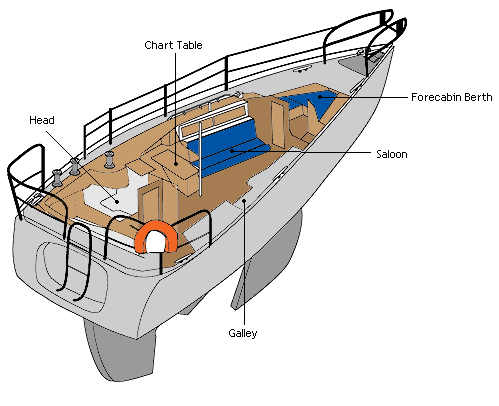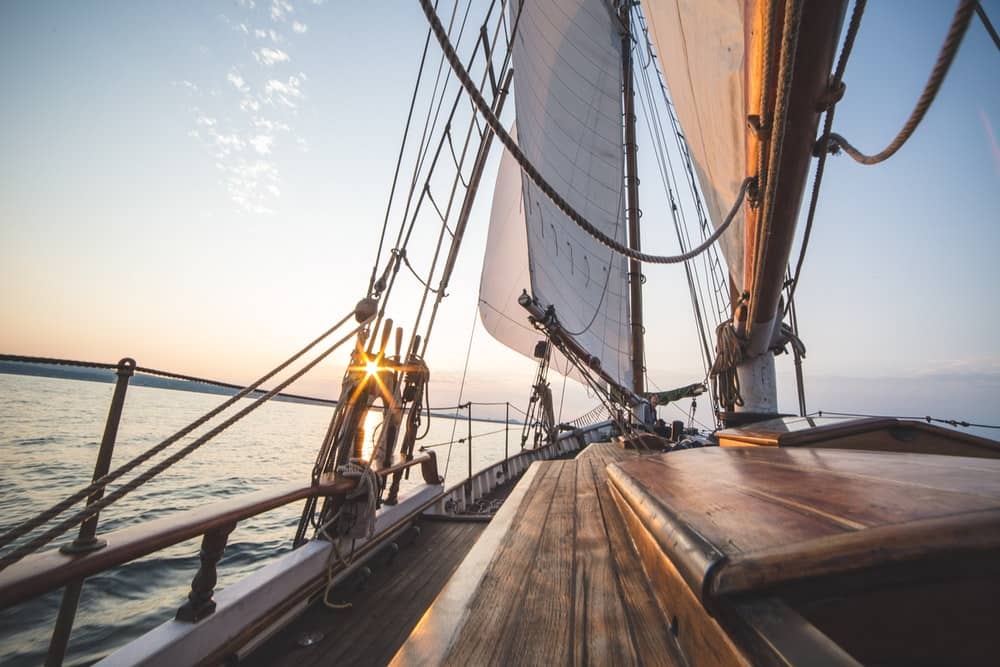Cruising Sailboats – Parts and Features
Compared to a Dinghy or other Small Boats, a Cruising Sailboat has more parts and features to suit the needs of people on board as well as the demands of Cruising. As the main equipment in this Sailing Variation, it is essential for all the people on board to know the different functions of each section in the Sailboat.
A Cruising Sailboat can be divided into three general components – Rigs, Deck, and the Cabin. Know the different parts, features, and functions of each component in the following sections:
Cruising Sailboat Parts – Rig
The Rig is the collective term, which refers to the Mast, Standing Rigging, spars, and the type and number of Sails by which the type is determined. For instance, a Rig with a Bermudan sloop is called a Bermudan sloop rig.
This is the unit that propels the Cruising Sailboat. It is the structure that derives energy from the Wind. Rigs have many parts and variations. In this section, know the different elements that make up the Rig:
Mainsail and Sails
The type of Rig lies in the number of Sails and the type of Mainsail. The Bermudan Mainsail is the commonly used type.
Parts
Cruising Sailboats can have different layouts of Standing Rigging, Running Rigging, and Sails. Here are the components of Rigs:
- Standing Rigging – a system of wires which holds the Mast up
- Forestay – The forestay is a wire or rope that runs from the bow to the masthead, and together with the backstay (which runs from the masthead to the stern), supports the mast fore and aft. A headsail may be attached to it.
- Backstay – a wire running from the masthead to the stern
- Shroud – a wire or rope which supports the Mast up and gives additional support by increasing the angle created by the Spreader and the Mast at the attachment point
- Spreader – supports the Mast and keeps the Shrouds away from the Mast
- Running Rigging – a collective term for all Lines (Halyards, Sheets) that raise, lower, and control the Sails
- Halyard – a line or rope which raises or pulls up the sail
- Mainsheet – A line or rope This controls the angle of the mainsail to the boat’s centerline. There is only one mainsheet, which is attached to the boom and is rigged as a multi-part tackle to provide power to adjust it. On larger boats, a winch is used to adjust the mainsheet.

As mentioned earlier, Rigging and Sails are very important in Cruising, for they are the ones that drive the boat. Know the components of Rigs as well as their functions so that boat handling will be easier and enjoyable.
Sailboat Deck Parts
Modern sailboats have a lot of fittings above deck, including the components of the spars and sails together with the ropes and hardware that controls them. Other equipment is needed for anchoring, mooring, and helping ensure the safety of the crew. Make sure you understand the purpose of the equipment on your boat.
The deck is the area or platform which is especially – designed for the operation of the Cruising Sailboat. Aside from being the primary working surface, it serves as the ‘lid’ of the Hull of the Sailboat and helps in strengthening it. Decks vary in structure or layout, depending on the type of Cruising Sailboat.
The deck holds many essential pieces of gear and equipment used in boat handling. In this section, know what these parts are and learn the role each of them plays in boat operations.
These Are The Deck Parts of a Typical Sailboat
- Foredeck: The part of the deck in front of the Mast
- Pulpit: A metal frame located at the bow of the boat; this is where forward Navigation lights are fastened
- Pushpit: A metal frame located at the stern of the boat; this is where stern Navigation lights and lifebuoys are attached
- Anchor well: It is a self-draining well just aft of the pulpit holds the anchor cable and often the anchor.
- Sidedecks: Spaces between the edge of the deck and the raised Cabin trunk (if any)
- Coach Roof: Serves as the cover of the raised Cabin trunk
- Hatches: Openings which allow light and ventilation in the Cabin
- Cockpit: The primary working place of the boat
- Sprayhood: Covers and protects the CockpitGenoa Car: Found on Sidedecks; track where the fairleads for the headsail sheet run
- Lockers: Storage compartments usually located under the seats in the Cockpit
- Sheet Winches: Winches are used to control sails, which produce loads larger than the crew can manage by hand. Most modern yachts have self-tailing winches that allow one-person operation. Winches without self-tailing jaws require two people to winch the rope—one person to wind the winch and the other to pull on the end, which is known as “tailing.”
- Lifelines: Lines that run from the Pulpit to the Pushpit on either side of the Deck

These are the basic things that you will see on the deck. Each is necessary when it comes to boat handling and other aspects of Cruising, so it is important to know how to use them properly.
Moreover, make sure to be careful when moving around the deck. Losing one’s footing and tripping on Deck gear are common when unwary crew members are on the deck.
Cruising Sailboat – Cabin Parts
One interesting component of Cruising Sailboats is the Cabin. This is the area that is nestled down in the Sailboat’s Hull. The size of the Cabin area generally depends on the length and height of the boat.
Obviously, there is just enough room for the basic gear and stuff in small Cruising Sailboats, while larger ones have spacious Cabins that can accommodate other things.
Like Rigs, the layout or arrangement of the parts of a Cabin may vary in different kinds of Cruising Sailboats.
Take a Look At The Basic Parts of a Typical Cabin:
- Galley: This is the kitchen area. It should be kept clean since this is the place for preparing food while onboard. It should also be equipped with a stove that is securely placed, so it stays upright. Moreover, a Galley must have relatively deep sinks. The kitchen equipment in the Galley will depend on the necessity and space available. Aside from the pans, plates, and utensils, you may add other culinary tools that you need if the space allows it.
- Chart Table: A navigator needs a place for Navigation and plotting work. This is where the Navigation Tools, nautical books and manuals, and some Communication Devices are placed.
- Head: This compartment usually has a marine toilet, washbasin, and lockers. All crew members need to understand how to use this. Otherwise, the unpleasant job of repairing the toilet will be necessary.
- Saloon: The Part of the Cabin for entertainment is called the Saloon. It should have a pleasant ambiance for relaxation. It must be well-ventilated with good handholds, or appendages to hold on to when the boat heels.
- Berth: Sometimes called the sleeping quarter, Berth is the area where crew members can rest and sleep. Install lee-cloths on the sea Berth to prevent yourself from falling off the Berth when the boat heels or during rough conditions.

Maximizing space is essential in a Cruising Sailboat, so make sure to store your gear and other personal stuff securely and adequately so the Cabin will stay tidy even when under rough conditions.
Cruising Sailboats – Parts and Features – Conclusion
These are the basic components of a Cruising Sailboat. Keep in mind that you need to know the different features of the boat in order to have a safe and enjoyable experience.
Also Read: Must-Have Boat Safety Equipment For Sailing
